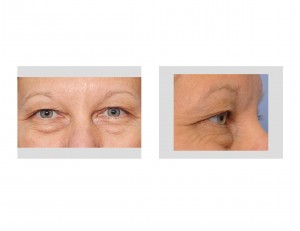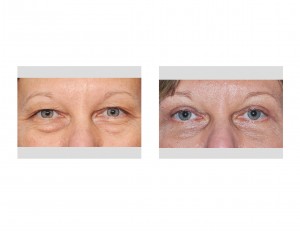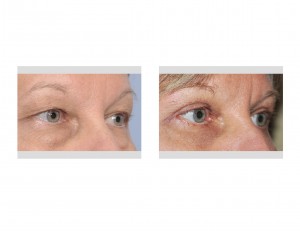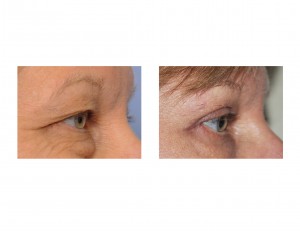Background: As one ages there are classic changes that occur around the eyes. Skin hangs down from the upper eyelids, wrinkles develop on the lower eyelid and radiate outward and lower eyelid bags develop, worse in some people than others. In addition, as we age our skin becomes thinner and more loose. As the cheeks underneath the eyes becomes hollow with fat atrophy, it causes the lower eyelid to sag or droop downward as well.
One element of this aging eye scenario is the puffiness that develops in the tissues, particularly on the lower eyelids. This is largely the result of herniated fat which extrudes beyond the vertical plane of the lower eye socket.This lower eyelid puffiness is also a cause of dark circles. Dark circles under the eyes are either created by the puffiness or aggravated by it. They result because of a shadow cast by the overhanging eye bag or puffy eyelid.
Many people have tried a myriad of hyped creams and even injections to get rid of their eye bags and dark circles, only to be ultimately disappointed. Frequently accused of inadequate sleep, people so affected get tired of being asked if they are tired. Ultimately, only blepharoplasty surgery can correct puffy eye problems.




To prevent this potential problem, a more conservative approach to lower eyelid surgery has become popular with the herniated fat causing the puffiness being removed from the inside lining (conjunctiva) of the lower eyelid. Limited skin removal is done by not raising a full lower eyelid skin flap but by pinching or rolling up some of the excess skin with a special instrument. This preserves the orbicularis muscle sling of the lower eyelid and causes little scar which can have a downward pulling effect. Because the blood supply to the lower eyelid skin is not disturbed, a simultaneous chemical peel can be safely done for a mild tightening effect and some reduction in the dark circles. This triple combination approach addresses all issues of puffy eyes with less risk of complications.
Case Highlights:
1) Aging around the eye area affects everyone in different degrees with the most severe manifestation being that of extreme puffiness of the lower eyelids
2) Puffiness around the eyes is associated with large amounts of redundant upper and lower eyelid skin and herniated fat with persistent tissue swelling.
3) Puffy eyes can be corrected with standard blepharoplasty techniques that emphasize aggressive upper eyelid skin removal, lower eyelid herniated fat removal and conservative lower eyelid skin resection.
Dr. Barry Eppley
Indianapolis, Indiana


